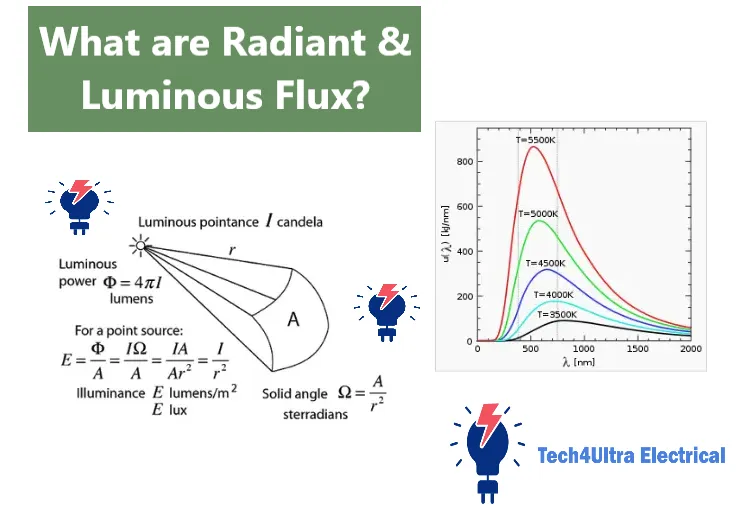Contents
Do you think the brightness you see from a light source is just one simple measure? Think again. There’s a big difference between radiant flux and luminous flux, and understanding that difference is key. Many people confuse the two, not realizing that one measures the physical power of light, while the other reflects how bright it appears to the human eye. In this article on the Tech4Ultra Electrical website, I’ll break down these two terms in a clear, practical way—so whether you’re a student, engineer, or lighting enthusiast, you’ll know exactly what they mean and how to use them.

Light isn’t just about visibility—it’s a form of energy transmission. When a source emits light, it’s releasing energy in the form of electromagnetic radiation. Understanding how this energy flows is crucial in fields like engineering, lighting design, and physics.
Two fundamental terms that help us describe this are radiant flux and luminous flux. These concepts allow engineers to calculate how much power a light source emits and how that power is perceived by the human eye. While radiant flux measures total energy emitted across all wavelengths, luminous flux focuses on the portion visible to humans, weighted by our eye’s sensitivity.
Whether you’re designing a streetlight or a solar panel, understanding the flow of light energy helps ensure efficiency, safety, and accuracy. In this section, we’ll lay the foundation for deeper insights into these powerful concepts.
What Is Radiant Flux?
Radiant flux is the total amount of electromagnetic energy emitted, transmitted, or received per unit of time. It includes all wavelengths of light—visible, ultraviolet, and infrared—and is measured in watts (W). In simpler terms, it’s how much light energy a source is pushing out every second, regardless of whether we can see it or not.
This concept is essential in physics and optical engineering because it represents the raw energy output of a light source. For example, the sun emits a massive amount of radiant flux, covering a broad spectrum of electromagnetic radiation, not just visible light. This makes it a key variable in designing devices like solar panels, lasers, and heat sensors.
Since it considers all electromagnetic radiation, radiant flux is purely a physical measure. It does not take into account how the human eye perceives brightness. That’s where luminous flux comes in—but more on that later.
If you’re working with any device that emits or receives light energy, understanding radiant flux is your starting point. It sets the baseline for how much energy is truly involved in the system.
Read Also: Photometry Explained: How We Measure Light the Way Humans See It
What Is Luminous Flux?
Luminous flux measures the total amount of light energy emitted by a source that is visible to the human eye. Unlike radiant flux, which includes all wavelengths of electromagnetic radiation, luminous flux focuses only on the wavelengths our eyes can detect—typically between 380 and 780 nanometers. It’s measured in lumens (lm).
This concept is central to photometry, the science of measuring light in terms of perceived brightness rather than physical energy. Since the human eye is more sensitive to green light than to red or blue, luminous flux is weighted by the sensitivity of our vision. In other words, two light sources might emit the same radiant flux, but the one emitting more green light will have a higher luminous flux.
In practical terms, luminous flux is what matters when designing lighting systems for homes, offices, or public spaces. Engineers and designers use it to determine how “bright” a space will feel to people, rather than just how much energy a light emits. That’s why you’ll see lightbulbs rated in lumens—it’s a direct reflection of their visible brightness.
So, if you’re aiming to optimize lighting for human environments, luminous flux is your go-to metric.
Radiant Flux vs Luminous Flux: Key Differences
Although radiant flux and luminous flux both deal with the emission of light energy, they serve different purposes and use distinct measurement criteria. Understanding their differences is essential in fields like lighting design, photometry, and physics.
| Aspect | Radiant Flux | Luminous Flux |
|---|---|---|
| Definition | Total electromagnetic power emitted per second | Perceived brightness by the human eye |
| Measurement Unit | Watt (W) | Lumen (lm) |
| Includes | All wavelengths (visible and non-visible) | Only visible spectrum, weighted by eye sensitivity |
| Used in | Physics, engineering, thermal calculations | Lighting design, photometry, visual comfort analysis |
One key factor that separates these two is spectral luminous efficiency, which represents how sensitive the human eye is to different wavelengths. For instance, a laser emitting 10 watts of infrared light will register high radiant flux but zero luminous flux—because we can’t see it.
On the other hand, a 10-watt white LED may have lower radiant flux but significantly higher luminous flux, since its emission aligns with the eye’s sensitivity curve.
If your goal is energy efficiency, radiant flux matters. If it’s visual comfort or brightness, luminous flux is what counts.
Radiant Power and Intensity Explained
To go beyond radiant flux, it’s important to understand how that energy is distributed in space and across surfaces. Two related terms help us with that: radiant intensity and radiant exitance.
Radiant intensity is the amount of radiant flux emitted by a source in a particular direction per unit solid angle, measured in watts per steradian (W/sr). It tells us how focused or directional a light source is—like in lasers or spotlights.
Radiant exitance, on the other hand, refers to the amount of radiant flux leaving a surface per unit area, measured in watts per square meter (W/m²). It’s often used in heat transfer and surface analysis, especially in thermal engineering.
These metrics are part of radiometry, which deals with measuring electromagnetic radiation. Specialized instruments like radiometers, spectroradiometers, and thermopile sensors are used to accurately capture radiant flux, intensity, and exitance across different spectral bands.
Whether you’re evaluating a high-power laser or analyzing solar panels, these distinctions help you understand how light behaves and interacts with its environment.
Photometry and Human Eye Sensitivity
In photometry, we measure light based on how the human eye perceives it—not just its physical energy. The bridge between radiant flux and luminous flux is the spectral sensitivity function, denoted as V(λ). This function describes how sensitive the average human eye is to different wavelengths of visible light.
At around 555 nm (green light), our eyes are most sensitive. This peak is the reference point for converting radiant flux into luminous flux. That’s why light sources emitting energy near this wavelength appear brighter, even if they emit the same power as other sources.
There are two types of vision based on lighting conditions: photopic vision and scotopic vision. Photopic vision occurs under well-lit conditions and is mediated by cone cells, which are sensitive to color. Scotopic vision kicks in under low-light conditions and is controlled by rod cells, which are more sensitive to light but not to color.
The visual response curve, or luminous efficiency function, graphically represents V(λ). It’s the foundation of photometric measurements and explains why two sources with equal radiant flux can appear very different in brightness to the human eye.
This understanding is critical for optimizing lighting systems for comfort, visibility, and efficiency.
Mathematical Formulas & Conversions
To convert radiant flux to luminous flux, we apply a formula that accounts for the eye’s sensitivity to different wavelengths. This conversion involves the spectral luminous efficiency function V(λ), and the constant 683 lm/W, which corresponds to the maximum photopic response at 555 nm.
The basic formula for monochromatic light is:
Luminous Flux (Φv) = 683 × V(λ) × Radiant Flux (Φe)
Where:
- Φv is the luminous flux in lumens
- Φe is the radiant flux in watts
- V(λ) is the spectral sensitivity at a specific wavelength λ
For polychromatic sources (those emitting multiple wavelengths), the formula becomes an integral:
Φv = 683 × ∫Φe(λ) × V(λ) dλ
This integral takes into account how the energy is distributed across the visible spectrum. It’s widely used in lighting design, especially for LEDs and other broadband sources.
Photometric efficiency or luminous efficacy is the ratio of luminous flux to radiant flux. It helps evaluate how efficiently a light source converts electrical or radiant power into visible light:
Efficiency (lm/W) = Φv / Φe
This makes it easier to compare different lighting technologies based on visual performance.
Measurement Tools and Techniques
Accurately measuring radiant flux and luminous flux requires specialized tools that match the nature of the measurement—physical energy or visual perception.
A radiometer is used to measure radiant flux across the electromagnetic spectrum. It detects the total power of incident radiation, including UV and infrared, making it ideal for scientific and thermal applications.
For luminous flux, photometric labs commonly use an integrating sphere. This device captures light emitted in all directions and integrates it over the interior surface, providing a highly accurate reading of total visible light output in lumens.
A goniophotometer goes further by measuring how light is distributed at different angles from a source. It’s essential for evaluating beam patterns and is frequently used in automotive lighting, streetlight design, and commercial fixtures.
In real-life use, these tools are indispensable in quality control, LED certification, and solar energy research. Whether in lighting factories or university photometry labs, precise measurement ensures compliance with safety standards, performance specs, and energy efficiency goals.
Applications in Engineering and Lighting Design
Engineers rely heavily on luminous flux when designing lighting systems for buildings, streets, and public infrastructure. It helps determine how much visible light reaches a surface, ensuring sufficient brightness for tasks without wasting energy. Architects and lighting designers use luminous flux data to calculate the number and placement of luminaires, optimize fixture selection, and comply with building codes and human comfort standards.
For example, in an office layout, designers might target 500 lumens per square meter (lux) to ensure readability and visual clarity. This planning is impossible without accurate luminous flux values from manufacturers or lab testing.
On the other side, radiant flux plays a major role in energy-focused systems like solar panels and laser technologies. In photovoltaics, engineers analyze radiant flux to estimate how much solar energy hits a panel over time. It’s key to maximizing power conversion efficiency and forecasting energy output.
In laser engineering, radiant flux determines the intensity and energy transfer capabilities of a beam. Whether used for cutting, communication, or medical treatment, controlling radiant flux is essential for precision and safety.
In short, both flux types serve distinct but critical roles across different branches of modern engineering.
Watch Also: Black Body Radiation Explained: Laws, Spectrum, and Real-World Applications
Common Misunderstandings and Clarifications
One of the most frequent misconceptions is thinking that radiant flux, luminous flux, brightness, and intensity all mean the same thing—they don’t.
Radiant flux is the total energy a light source emits per second, while luminous flux is how much of that energy is visible to the human eye. Brightness, on the other hand, is not a physical measurement—it’s a subjective perception that can vary based on contrast and environment.
Intensity also adds confusion. In physics, it often refers to radiant intensity—energy per solid angle. But people casually use “intensity” to describe how “strong” or “bright” a light feels, which blurs its true definition.
Understanding these distinctions is essential for accurate communication and design, especially in engineering, lighting, and physics. Each term has a specific role and should be used in context to avoid technical errors.
Conclusion: Why Understanding Both Matters
Whether you’re designing a lighting system, optimizing a solar panel, or analyzing optical equipment, knowing the difference between radiant flux and luminous flux is crucial. One measures real energy output; the other reflects human perception. Confusing the two can lead to poor decisions in engineering, energy efficiency, and visual comfort.
By understanding both, you gain precise control over how light behaves—and how people experience it. That’s the kind of knowledge that separates smart design from guesswork.
FAQs
What is the radiation flux?
Radiation flux is another term for radiant flux. It refers to the total electromagnetic energy emitted, transferred, or received per unit time. It’s commonly measured in watts (W) and includes all wavelengths—visible and invisible—across the electromagnetic spectrum.
How to calculate the radiant flux?
To calculate radiant flux, you measure the energy output over time from a light source. For monochromatic light, it’s often measured using specialized sensors or radiometers. For complex sources, you may need to integrate the power distribution over all emitted wavelengths and angles.
What is the radiant flux?
Radiant flux is the rate at which radiant energy is emitted, transferred, or received. It’s a fundamental measure in radiometry and forms the basis for evaluating light power in physics and engineering, regardless of visibility to the human eye.
What is radiometric flux?
Radiometric flux is another name for radiant flux. It specifically refers to energy measured across the full spectrum using radiometric methods, without considering human visual sensitivity. It’s used in scientific applications where total energy output matters.
How do you measure radiant flux?
Radiant flux is measured using radiometric instruments such as radiometers or spectroradiometers. These devices detect the total electromagnetic energy emitted per second from a source, typically in watts (W).
What does flux tell you?
Flux tells you the rate at which energy or particles pass through a surface or space. In the context of radiant flux, it indicates the total light energy output from a source per unit time.
What is the main purpose of flux?
The main purpose of measuring flux—whether radiant or luminous—is to quantify the energy transfer in a system. This helps in evaluating performance, efficiency, and suitability in engineering, lighting, and energy systems.
What is the difference between flux and magnetic flux?
Radiant flux deals with the flow of electromagnetic energy (light), while magnetic flux measures the strength and direction of magnetic fields across a surface. They are related in concept but apply to entirely different physical phenomena.
Is flux positive or negative?
Flux can be positive or negative depending on the direction of energy flow. For radiant flux, it’s usually considered positive when energy is emitted and negative when it’s absorbed.
What is the formula for flux?
The basic formula for radiant flux is:
Φ = dQ / dt
Where Φ is the flux, dQ is the amount of energy, and dt is the change in time. For directional sources, more advanced formulas involve integration over angles and wavelengths.
What is magnetic flux?
Magnetic flux measures the total magnetic field passing through a surface. It’s calculated using the formula:
Φ = B × A × cos(θ)
Where B is the magnetic field strength, A is the area, and θ is the angle between the field and the normal to the surface. It is measured in Webers (Wb).
Is flux a liquid or solid?
Neither. Flux is not a material but a concept—it’s a measure of the flow of something, such as energy or particles, through space or a surface. In radiant flux, it refers to energy per unit time, not a physical state like liquid or solid.


2 thoughts on “Watts Law Explained: Complete Guide to Electrical Power with Examples and Calculations”